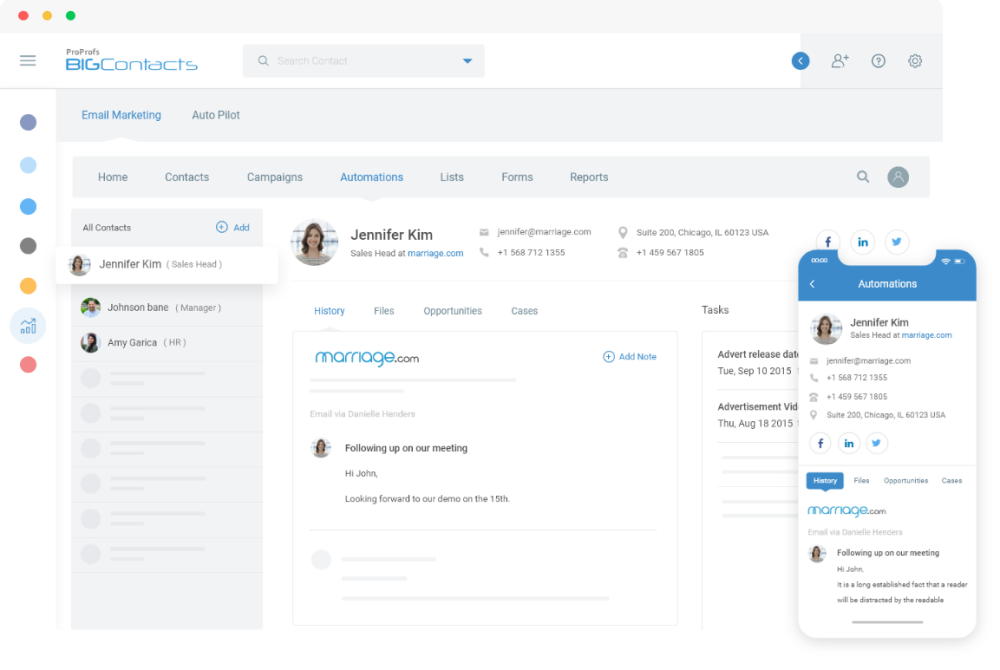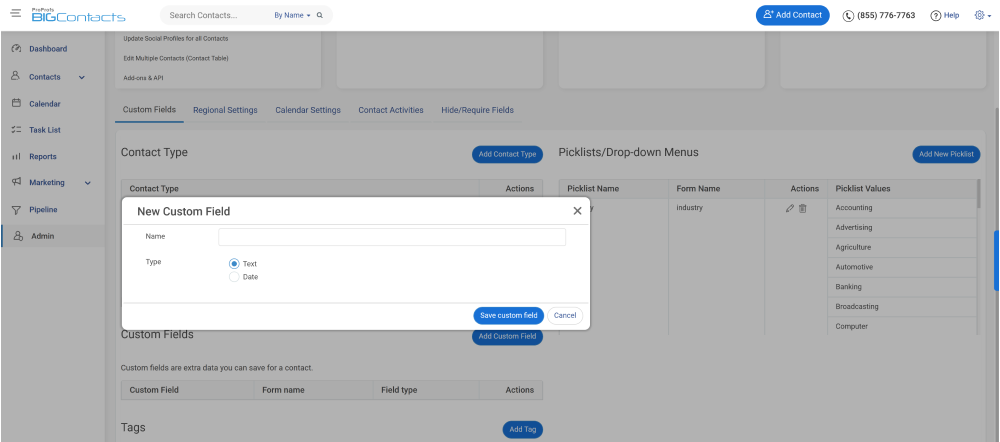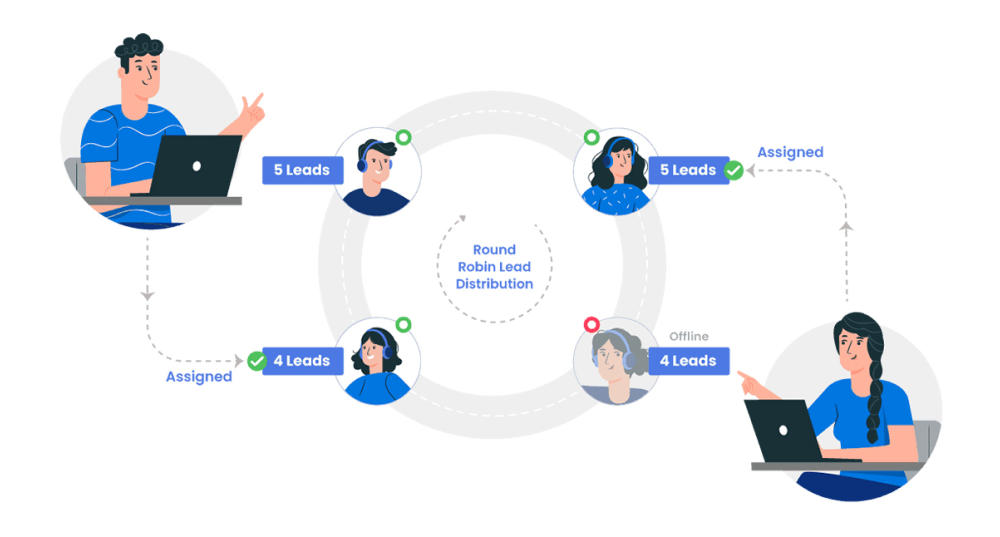If you thought generating high-quality leads was the ultimate challenge, you’re both right and wrong.
Right – because low-quality leads mostly end up in the sales bin, which means you do need high-quality leads. And wrong – because generating leads is just the first step to acquiring new customers. What’s more important is nurturing them through skilled sales reps.
And this is where lead distribution comes in.
Without a well-planned lead distribution strategy, assigning prospects to representatives randomly may not always work.
But, with a lead distribution CRM (new to this? Check the video below) and definite strategies, it’s bound to. And that’s what this blog is all about.
What Is Lead Distribution?
Lead distribution is the strategic process of assigning potential clients or ‘leads’ to various sales representatives within your organization.
It ensures that the leads are nurtured by reps who possess the ideal skills, experience, and industry knowledge to effectively convert them into paying customers.
Sounds too complicated? I’ll simplify it with an example.
Imagine you run a software company that caters to both small businesses and large enterprises. A lead from a startup wouldn’t require the same sales approach as one from a Fortune 500 corporation, right? So, by strategically distributing these leads, you equip your reps with the best chance of success.
This process of lead routing to the most suitable sales personnel is lead distribution.
What Is the Lead Distribution Process?
Lead distribution can be divided into several phases. Following a well-planned process is the key to ensuring no leads are assigned to someone without expertise.
Apart from that, you’ll also learn how a CRM software solution helps in the process. Let’s begin.
Phase 1: Lead Capture
It all begins with lead capture. ‘Leads’ or potential customer information is collected through various channels such as websites, social media, live events, inbound calls, lead generation surveys, or marketing campaigns.
But how can you stop these leads from getting scattered everywhere? Spreadsheets? Not really. Get a CRM software solution instead.

And here’s why –
- CRM software acts as a central repository for all lead information.
- It integrates with web forms, email systems, and social media platforms to automatically import lead details into the database, saving you a lot of manual effort.
- Such a software solution also keeps information synchronized and accessible for everyone.
Phase 2: Lead Qualification
Next, each lead is evaluated based on specific criteria to determine their potential value and readiness to purchase. This phase involves:
- Initial Screening: Eliminating irrelevant or low-quality leads that do not meet your basic criteria.
- Scoring Leads: Using a lead scoring system to prioritize leads based on factors like engagement level, demographic information, and buying potential.
Now, let’s discuss how qualifying leads becomes more effortless when you use a CRM system.
A CRM system can automate the lead qualification process by applying scoring rules based on the lead’s actions, such as website visits, downloads, or email engagement. This helps you prioritize leads that show a higher potential for conversion – eventually allowing sales teams to focus their efforts where it counts.
Phase 3: Lead Segmentation
Next, leads are segmented into different categories based on predefined criteria like demographics, behavior, etc. Lead segmentation helps in tailoring the sales approach to the lead’s specific needs and interests.
CRM software harnesses the power of data analytics to segment leads accurately. By analyzing historical data and current interactions, it identifies patterns and trends that inform the segmentation criteria.
Phase 4: Sales Rep Profiling
This is the part where you need to evaluate your sales teams. The best person to do that would be the one in charge (say, a sales or team manager) or automatically through a CRM system.
Some common criteria to look for when profiling sales reps are –
- Geographic Location: Assigning leads to sales reps who handle specific territories.
- Product or Service Expertise: Matching leads with reps who specialize in the product or service the lead is interested in.
- Industry or Sector Knowledge: Aligning leads with reps who have experience in the lead’s industry, ensuring a more tailored sales approach.
Apart from these, self-assessment can also be an effective way to assign leads. Wondering what that means?
For example, many CRMs allow for customizable user fields. Consider creating fields that reps can use to identify leads with their preferred industries, product areas, or communication styles.

Phase 5: Team Communication
The job still isn’t done after you profile sales reps and assign them leads to nurture.
Your representatives must grasp the rationale behind your lead distribution strategy. They should have a clear understanding of the individuals they’ll be engaging with and why they are best suited to handle them.
The best way to maintain transparency here is to have an open communication channel. Using CRM software that offers team communication features is a big bonus.
For example, you should be able to add comments and notes or tag team members. Some tools even let you schedule team meetings and send out email reminders.
What Are Some Common Lead Distribution Strategies?
Using lead distribution software to create a lead assessment and distribution strategy can benefit your sales and marketing team. Let’s discuss some of the key strategies below, as well as the role of CRM software in them.
Round Robin Distribution
This method ensures fairness by distributing leads evenly among available reps. It’s a good starting point for teams with a consistent lead flow and similar rep skillsets.

CRM software automates this process, eliminating manual intervention and ensuring all reps receive an opportunity to work with qualified leads.
Here’s a quick guide on how to set up round-robin distribution in most CRM systems:
- Navigate to the settings or administration section of your CRM.
- Locate the lead distribution or lead routing options.
- Look for a setting labeled “round robin” or “equal distribution.”
Enable this option and define additional parameters, such as whether to include inactive reps or assign leads based on a specific timeframe (e.g., daily or weekly).
Remember, round-robin distribution is a simple but effective strategy. But, as your lead volume grows or your sales team matures, you can graduate to more sophisticated methods like weighted distribution or skills-based routing for a more targeted approach.
Lead Scoring
Many CRMs provide lead-scoring functionalities. Assign points to leads based on various factors that indicate their sales readiness, such as website visits, content downloads, or engagement with marketing campaigns.
Leads with higher scores can be automatically routed to top-performing reps with proven track records, while lower-scoring ones might be directed to nurturing campaigns before rep assignment.
Some of the best practices for lead scoring include –
- Carefully choose lead attributes to ensure the lead score isn’t inflated compared to the prospect’s actual interest
- Have a clear understanding of the buyer’s persona
- Use a CRM system to automate the lead allocation and scoring process and save time
- Leverage reports and analytics to track whether qualified leads are actually translating into converted opportunities
Read More: 10 Lead Scoring Best Practices To Improve Your Sales Lead Quality
Weighted Distribution
For a more sophisticated approach, use weighted distribution.
Assign weights to reps based on factors like performance history, expertise in specific industries or product areas, or current capacity. Leads are then automatically routed to the rep with the highest weighted score.
This method ensures leads are directed to the reps best suited to convert them, considering both skillset and workload balance.
Skills-Based Routing
This advanced option allows you to define specific skills required for different lead types within your CRM.
For instance, leads requiring technical expertise can be routed to reps with relevant certifications. In contrast, leads seeking a consultative approach can be matched with reps known for their strong communication skills.
The CRM then automatically matches leads with reps possessing the necessary skillset for optimal conversion potential.
Ideally, this process of lead assignment is best for businesses with –
- Specialized Sales Teams: If your sales team caters to diverse industries, product lines, or customer segments, skills-based routing is the best choice.
- Complex Sales Cycles: For intricate sales processes that require a specific approach or technical expertise, skills-based routing guarantees leads are assigned to reps equipped to navigate the complexities of the sale.
- High-Value Leads: When dealing with high-value leads, it’s crucial to maximize the chance of conversion. That is possible when you embrace skills-based routing. As those leads are matched with your most experienced and qualified reps, it boosts the likelihood of a successful outcome.
Geographic Targeting
Of all the lead routing processes above, this one is pretty straightforward. Utilize geo-location features to route leads to reps located in the same region. This can be particularly beneficial for businesses with a geographically dispersed salesforce, fostering stronger relationships with local leads.
So, what you need to do is –
- Divide lead groups based on their geographical regions
- Assign the distribution task to a territory manager for each area
This approach enables consideration of representatives’ familiarity with regional preferences, location-specific requirements, and prevalent personas in each area.
Manual Routing
As the name suggests, ‘manual’ routing or distribution means assigning leads to your sales representatives personally. This gives you more control over how leads are handed out compared to other methods. You can make sure each rep gets the right leads based on certain criteria.
But then, this process is only suitable for startups with a micro team. The most apparent downside is that it takes a lot of time and effort to assign leads manually, especially if you have a big team. It might not be worth it if you have a lot of reps to manage.
Why Is Lead Distribution Important?
Effective lead distribution offers a multitude of benefits for your sales team and bottom line. Let’s explore some key reasons –
- Increased Conversion Rates: Reps with expertise in the lead’s industry can tailor their approach, addressing specific pain points and demonstrating a deeper understanding of their needs – leading to higher conversion rates.
- Improved Sales Efficiency: Strategic lead distribution prevents reps from wasting time on unqualified leads. By focusing on leads most aligned with their skill set, reps can concentrate their efforts and close deals faster.
- Enhanced Rep Satisfaction: When reps consistently receive leads that match their strengths and interests, they feel more engaged and motivated.
- Data-Driven Decision Making: Using a CRM platform for effective lead distribution ensures you have valuable data on lead quality, rep performance, and conversion rates. This data empowers you to identify trends, optimize your strategy, and allocate resources efficiently.

Why Should You Automate Lead Distribution?
Manual lead distribution is time-consuming and prone to human error. That is why it is essential to have a CRM system that automates the process, freeing up your sales team to focus on closing deals.
Additionally, automation ensures –
- Fairness and Transparency: Automated rules eliminate bias and ensure all reps receive an equal opportunity to work with high-quality leads.
- Faster Lead Response Time: Leads are routed immediately, minimizing the window of opportunity for competitors.
- Improved Data Accuracy: Automation minimizes data entry errors, providing you with reliable information for informed decision-making.
- Better Resource Allocation: By automating routine tasks, sales reps can focus their time on what they do best—selling.
- Scalability: As your business grows, the volume of leads can become overwhelming for manual processes. Automation allows you to scale your lead distribution efforts without a corresponding increase in administrative overhead.
Make Lead Distribution Effortless With CRM
Even high-quality leads may not convert if not nurtured properly. 2 of an experienced and skillful sales rep.
It’s needless to say how a CRM system can help not just lead distribution but also generate and nurture them.
Of the many tools I have used over the last few years, BIGContacts is one that I find unique. Especially if you have a small business, you will find its combination of CRM and email marketing helpful.
But no matter which software you choose, test it first to see how it fits into your business workflow. For example, BIGContacts offers a freemium plan, which is great for testing the software. Try it today to cut down the time you spend on distributing leads and focus more on converting them.
Learn More About Lead Distribution
What is lead distribution in a CRM?
Lead distribution in a CRM is the automated process of assigning incoming leads to specific sales reps based on pre-defined criteria and lead information. This ensures leads are connected with the reps with the skills, experience, and industry knowledge to best nurture and convert them into paying customers.
How do I allocate leads?
For effective lead allocation, you must strategically assign incoming leads to individual sales reps within your team. Factors considered during lead allocation can include –
- Lead Qualification: Budget size, industry, and decision-making authority within the lead’s company.
- Sales Rep Skills: Expertise in specific products, communication style, and sales methodology.
- Additional Considerations: Rep availability, workload, and geographic location (for regional teams).
CRM software can automate lead allocation based on pre-defined rules, ensuring maximum efficiency.
What’s the difference between lead generation, lead capture, and lead distribution?
The fundamental idea among these three terms is –
- Lead generation is attracting potential customers who show initial interest in your product or service.
- Lead capture is the process of collecting contact information from interested leads.
- Lead distribution assigns these captured leads to the most suitable sales rep for nurturing and conversion.
In all these three stages, a CRM software solution benefits your sales and marketing teams.
What is the difference between manual lead distribution and automated lead distribution?
Manual lead distribution is the process of allocating leads to sales reps manually, one by one. This practice is best for companies having micro teams. But, if you have a medium to large-sized team, it may take a lot of time.
On the other hand, automated lead distribution is the allocation of leads through software solutions. This process is ideal for both small and large teams, as it saves a lot of time allocating leads to sales reps.
Is lead distribution, lead routing, and lead allocation different things?
Lead distribution, routing, and allocation are essentially the same thing. They all refer to the process of assigning qualified leads to the most suitable sales reps within your team. These terms are often used interchangeably.
FREE. All Features. FOREVER!
Try our Forever FREE account with all premium features!







